Like some autistic kids, my son has poor fine motor skills which affect his everyday life. Getting into occupational therapy (OT) has been nothing short of a feat. It is not unusual to be placed in a three-to six-month waiting list. In my experience once you get in, you often get an hour a week and if your stars are aligned right, maybe twice a week. Then comes insurance which, in our case, believes my child does not really need this therapy. If I convince them he does, I get covered for maybe 12 to 15 sessions a year. So, in between the waiting, the long gaps between sessions, the power play with insurance and the rest, I was left with a lot of time in my hands. I decided to use this time for therapies we could do at home.
This is a list of activities that have worked for my son. I’ve seen real success and these are easy to set up — and fun, too.
Lacing beads :
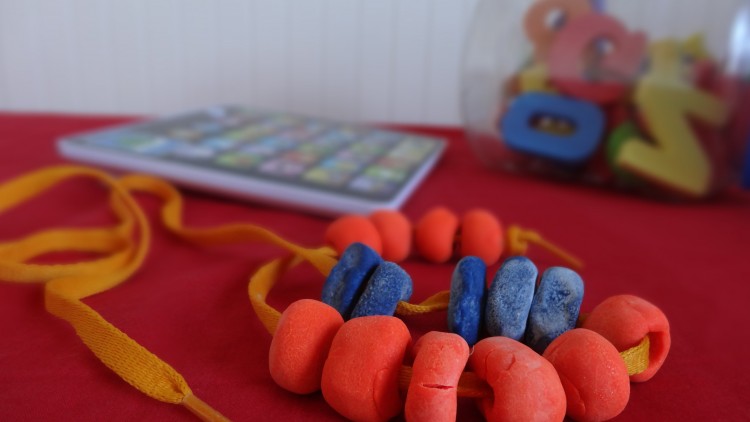
What you need — (option 1) pipe cleaner, Cheerios (option 2) Play-Doh, shoe lace
The activity — This helps with the pincer grasp and with hand-eye coordination. All you need to do is help your child push Cheerios onto a pipe cleaner. Several websites, instead of using a pipe cleaner, suggest using raw spaghetti propped on a ball of Play-Doh, but my son likes to fiddle and the pasta breaks. Pipe cleaners work better for us. Once my son mastered this, we moved on to a more challenging lacing exercise. I made beads out of Play-Doh (grape size balls and I poked holes with a skewer). I let them dry overnight. I use a shoe lace with a knot tied at one end to stop the beads from falling out and then I help my son lace the beads through. It took some sessions of frustration but he eventually got it. Now he’s a pro.
Make it fun — To make this task more interesting, you can use multicolored Fruit Loops and make bracelets out of it. The shoe lace with chunky Play-Doh beads looks like a tribal neck-piece, which is a great incentive for my son to work for.
Using tweezers:
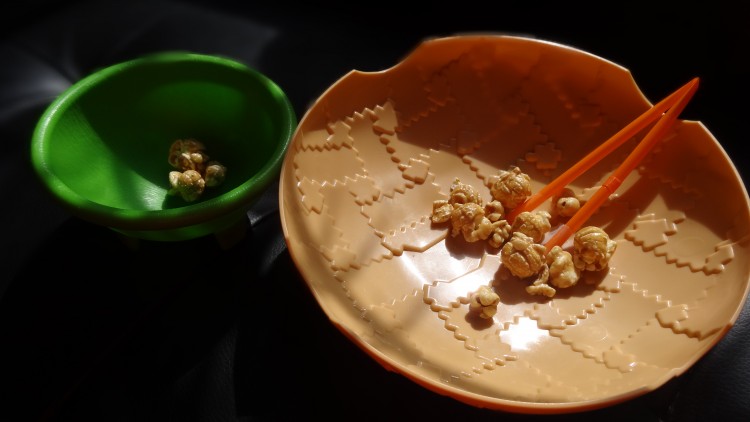
What you need — tweezers/tongs/straws, popcorn
The activity — Chances are you have a pair of tweezers at home. Put some popcorn in a bowl and help your child serve each of you a small portion using the tweezers. For those who don’t have tweezers, a straw bent at the middle works just fine. However, when you switch to picking heavier stuff than popcorn, you might consider getting one of those kids tongs for this exercise.
Make it fun — Set a timer and race against each other for who gets the most popcorn.
Paper crumple:
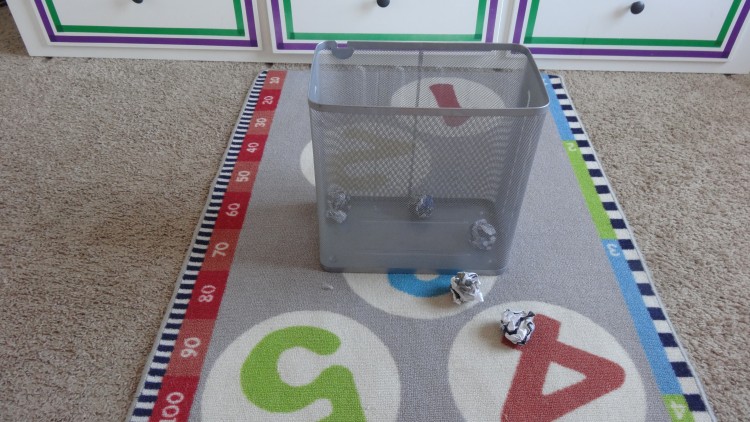
What you need — Old magazines, trash can
The activity — This is another fun activity. Grab a few old magazines. Sit next to your child and place a trash can in front of you, not too far. Take turns ripping off paper from the magazine, crumpling it into a ball, and throwing it into the can. This activity has three components: tearing, which requires finger manipulation; crumpling paper into a tight ball, which increases hand strength; aiming at the basket, which is a good hand-eye coordination exercise. Also, tearing paper is a precursor to acquiring skills for many daily activities like writing, opening sealed bags, or shredding pieces of food.
Make it fun — Start a two-person match and keep score of who makes more baskets.
Sponge squeeze:
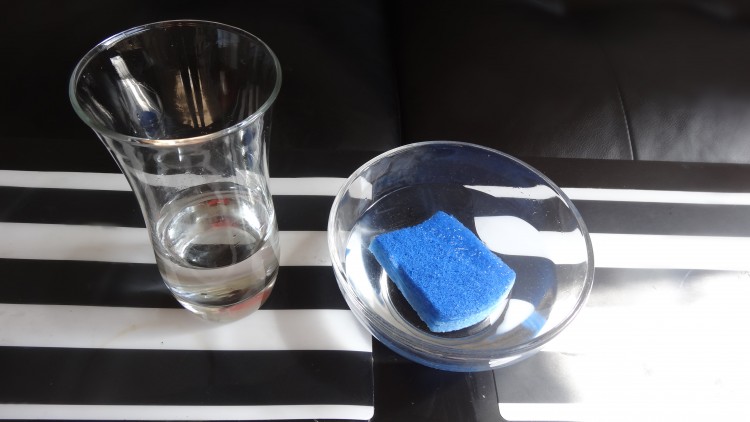
What you need — clean sponge, water, cup
The activity — This is another hand strengthening exercise that my son loves, especially because it involves water. Soak a sponge in water and let your child squeeze the water out into a cup or bowl.
Make it fun — Bring out a few bowls of water and add food coloring. Set up a fake slush or juice bar by squeezing the colored water in different glasses.
Coin bank:
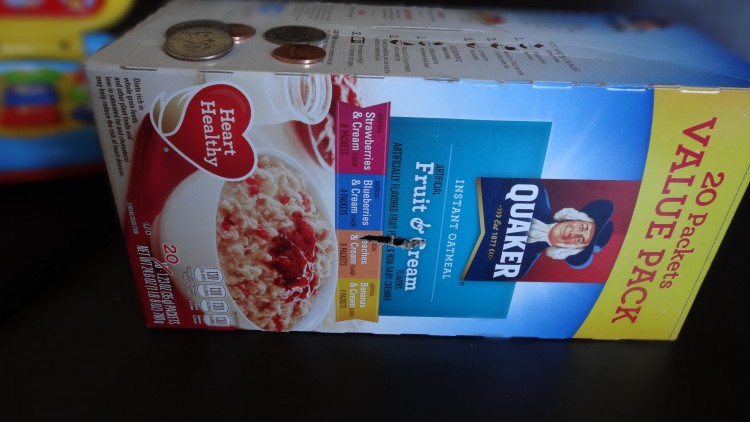
What you need — cereal/shoe box, coins
The activity — My son loved going to Chuck E. Cheese’s and needed our help every time he had to insert tokens. That’s when we realized how important it was to work on this skill. Take a cereal box, (I used a Quaker’s oatmeal box) and make a small vertical slit on one side, and a horizontal one on the other side (big enough for a coin to go through). I began this activity by placing the box so the slit was on top, switching between dropping the coin through the vertical and a horizontal slits. Since it’s easier to push through a slit that’s on top rather than on the side, I waited until he mastered the top slits before moving on. I then flipped the box so that the slit faced the side. This one took some time to master but my son is now an expert — if he is paying attention.
To make things more challenging, you can let your child pick up the coins on his own. Once they’ve mastered this skill, add another level of challenge by giving them a couple of coins in their hands and letting them use the same hand to push the coins into the slit. Both of these options will encourage in-hand manipulation skills.
Make it fun — Create a play zone for your kid with his favorite toys lined up. Allocate different coin counts for each toy. Let your child “deposit” coins in the box for any toy he wants to play with.
Pipe cleaner & colander:
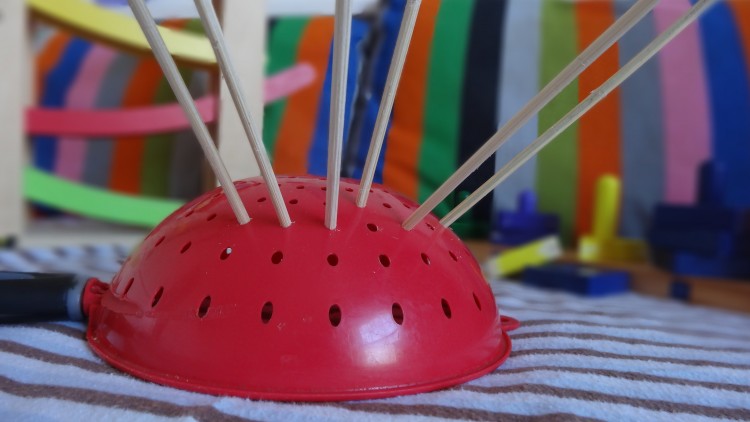
What you need — colander, pipe cleaners, bamboo skewers
The activity — This one is similar to lacing beads. Turn a colander upside down and help your child insert pipe cleaners through its holes. You could then move on to bamboo skewers. Try selecting skewers that fit snugly through the colander holes. I find these more challenging because they require a little more strength to push through the holes and it helps with hand strength. Pulling these skewers out is just as challenging because my son needs to hold down the colander and then pull out the skewers. It really helps with his motor strengthening skills.
Make it fun — Once you have all the pipe cleaners in the colander, loop those back into another hole or twist those around in different shapes and make funny hats out of the colander. You could make porcupines out of the bamboo skewers too but be careful, they are prickly.
There are several other games that have helped my son acquire the fine motor skills he struggles with. Everyday activities present us with several opportunities to do so. Besides, they provide a meaningful goal for an activity rather than just sitting at a table and doing a list of tasks.
Some other activities we do:
Peeling fruit (like oranges and bananas) for finger manipulation.
Pouring water or juice in glasses for hand-eye coordination.
Help carry groceries for motor exercise (and some kids feel proud helping mom or dad).
Whisking an egg or a batch of cookies, for hand exercise.
You could store a favorite treat in a container with a screw-on lid and when your child asks for one, have them open the container on their own.
If they ask for a candy, ask them to unwrap it or open that M&M bag themselves. I’ve found that motivation is a big driving force for learning.
Get a wind up toy your child likes and watch them build their hand manipulation skills as they crank it up.
When a package arrives, don’t throw the bubble wrap away. Have fun popping them with your child.
Last week I needed a lot of butter for something I was cooking and I asked my son to unwrap all the butter sticks for me. He struggled initially and got a little frustrated but we finally worked our way through all 16 sticks. By the time we finished, he was already unwrapping on his own.
In my personal experience, making an activity fun and purposeful is an important factor in learning. Our homes are filled with opportunities to teach and to learn. Sometimes it requires thinking outside the box a little. Also, I’ve experienced the more chances I give my son to do chores around the house, the more skills he acquires. In spite of his challenges, I try to give him as much independence as I can for him to learn and grow.
Have fun being a “mommy therapist.”
Editor’s note: This story is based on an individual’s experience and should not be considered medical advice. Please consult a doctor or medical professional for any questions.
We want to hear your story. Become a Mighty contributor here.

